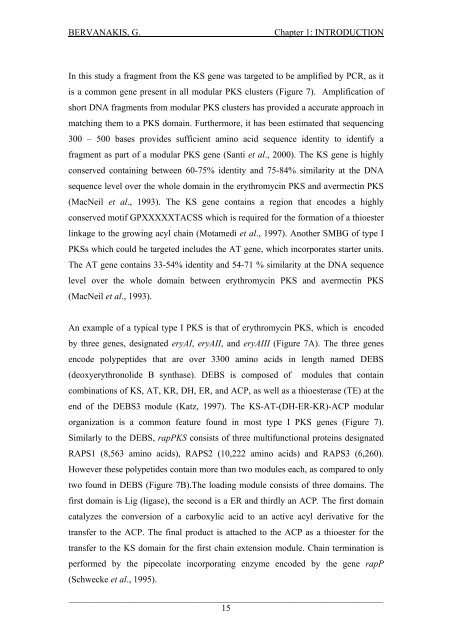Detection and Expression of Biosynthetic Genes in Actinobacteria ...
Detection and Expression of Biosynthetic Genes in Actinobacteria ...
Detection and Expression of Biosynthetic Genes in Actinobacteria ...
Create successful ePaper yourself
Turn your PDF publications into a flip-book with our unique Google optimized e-Paper software.
BERVANAKIS, G.Chapter 1: INTRODUCTIONIn this study a fragment from the KS gene was targeted to be amplified by PCR, as itis a common gene present <strong>in</strong> all modular PKS clusters (Figure 7). Amplification <strong>of</strong>short DNA fragments from modular PKS clusters has provided a accurate approach <strong>in</strong>match<strong>in</strong>g them to a PKS doma<strong>in</strong>. Furthermore, it has been estimated that sequenc<strong>in</strong>g300 – 500 bases provides sufficient am<strong>in</strong>o acid sequence identity to identify afragment as part <strong>of</strong> a modular PKS gene (Santi et al., 2000). The KS gene is highlyconserved conta<strong>in</strong><strong>in</strong>g between 60-75% identity <strong>and</strong> 75-84% similarity at the DNAsequence level over the whole doma<strong>in</strong> <strong>in</strong> the erythromyc<strong>in</strong> PKS <strong>and</strong> avermect<strong>in</strong> PKS(MacNeil et al., 1993). The KS gene conta<strong>in</strong>s a region that encodes a highlyconserved motif GPXXXXXTACSS which is required for the formation <strong>of</strong> a thioesterl<strong>in</strong>kage to the grow<strong>in</strong>g acyl cha<strong>in</strong> (Motamedi et al., 1997). Another SMBG <strong>of</strong> type IPKSs which could be targeted <strong>in</strong>cludes the AT gene, which <strong>in</strong>corporates starter units.The AT gene conta<strong>in</strong>s 33-54% identity <strong>and</strong> 54-71 % similarity at the DNA sequencelevel over the whole doma<strong>in</strong> between erythromyc<strong>in</strong> PKS <strong>and</strong> avermect<strong>in</strong> PKS(MacNeil et al., 1993).An example <strong>of</strong> a typical type I PKS is that <strong>of</strong> erythromyc<strong>in</strong> PKS, which is encodedby three genes, designated eryAI, eryAII, <strong>and</strong> eryAIII (Figure 7A). The three genesencode polypeptides that are over 3300 am<strong>in</strong>o acids <strong>in</strong> length named DEBS(deoxyerythronolide B synthase). DEBS is composed <strong>of</strong> modules that conta<strong>in</strong>comb<strong>in</strong>ations <strong>of</strong> KS, AT, KR, DH, ER, <strong>and</strong> ACP, as well as a thioesterase (TE) at theend <strong>of</strong> the DEBS3 module (Katz, 1997). The KS-AT-(DH-ER-KR)-ACP modularorganization is a common feature found <strong>in</strong> most type I PKS genes (Figure 7).Similarly to the DEBS, rapPKS consists <strong>of</strong> three multifunctional prote<strong>in</strong>s designatedRAPS1 (8,563 am<strong>in</strong>o acids), RAPS2 (10,222 am<strong>in</strong>o acids) <strong>and</strong> RAPS3 (6,260).However these polypetides conta<strong>in</strong> more than two modules each, as compared to onlytwo found <strong>in</strong> DEBS (Figure 7B).The load<strong>in</strong>g module consists <strong>of</strong> three doma<strong>in</strong>s. Thefirst doma<strong>in</strong> is Lig (ligase), the second is a ER <strong>and</strong> thirdly an ACP. The first doma<strong>in</strong>catalyzes the conversion <strong>of</strong> a carboxylic acid to an active acyl derivative for thetransfer to the ACP. The f<strong>in</strong>al product is attached to the ACP as a thioester for thetransfer to the KS doma<strong>in</strong> for the first cha<strong>in</strong> extension module. Cha<strong>in</strong> term<strong>in</strong>ation isperformed by the pipecolate <strong>in</strong>corporat<strong>in</strong>g enzyme encoded by the gene rapP(Schwecke et al., 1995)._____________________________________________________________________15















